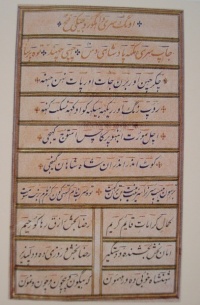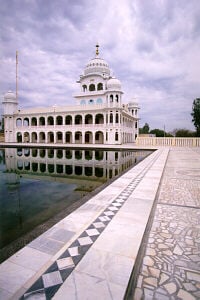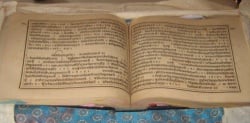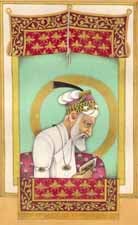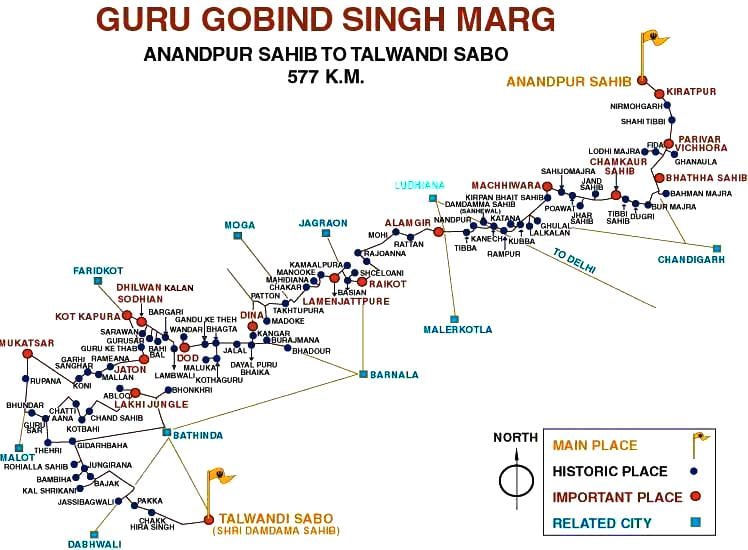Zafarnama
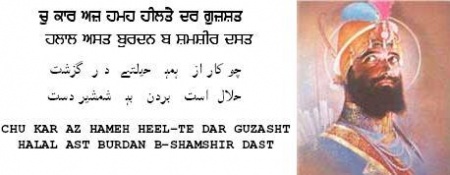
Zafarnama (Gurmukhi: ਜ਼ਫ਼ਰਨਾਮਹ or ਜ਼ਫ਼ਰਨਾਮਾ, Persian: ظفرنامہ ) means the "Declaration of Victory" and is the name given to the letter sent by the tenth Sikh Guru, Guru Gobind Singh in 1705 to the Emperor of India, Aurangzeb. The letter is written in exquisite Persian verse. In this letter, Guru Ji reminds Aurangzeb how he and his henchmen had broken their oaths taken on the holy Koran. Zafarnama is included in Hikayats and it's the first Hikayat.
Despite this deception, this treacherous leader could not harm the Guru. Guru Ji states in this letter that in spite of his several sufferings, he had won a moral victory over the crafty Mughal who had broken all his vows and had resorted to underhand behaviour. Despite sending a huge army to capture or kill the Guru, the Mughal forces did not succeed in their mission.
Brief content of letter
The letter reads like a reprimand by a superior personality on a higher plane to a cruel and distorted inhuman being on a lower and pitiful plane. Guru Ji in the 111 verses of this notice rebukes Aurangzeb for his weaknesses as a human being and for excesses as a leader. Guru Ji confirms his confidence and his unflinching faith in the Almighty even after suffering extreme personal loss.
Of the 111 verses, the maximum numbers of 34 verses are to praise God; 32 deal with Aurangzeb’s invitation for the Guru to meet him and the Guru's refusal to meet the Emperor - instead Guruji asks Aurangzeb to visit him going so far as to guarantee that no harm will come to him. Though parts of the letter are an indictment of Aurangzeb and the treachery of his Mughal Generals and forces, other parts of the letter are like one from an older wiser veer (brave or valiant brother) more in touch with the part of the jyot (light) of God in his heart, who though terribly wronged on one plane, is asking his lost veer, who he sees as having lost touch with the promise of his own religion and its Holy Koran, to return to the fold of brotherly love and make things right between them again. Amazingly 6 verses actually praise Aurangzeb.
24 verses detail the events in the Battle of Chamkaur, which took place on 21 and 22 December 1704; 15 verses reprove Aurangzeb for breaking written promises given by him and his Officers, written in the blank pages of a copy of the Qur'an, given to the Guru; In verses 78 and 79, the Master had also warned Aurangzeb about the resolve of the Khalsa not to rest until his empire and its evil practises is driven out of India or destroyed.
Background
The second fortnight of December 1704 was the most difficult and critical period in the life of Guru Gobind Singh Ji. It was during this period that forty Majhail Sikhs had deserted the Guru, the city of Anandpur had to be vacated, the Sarsa floods had brought havoc, Guru Ji's family had become separated, his two elder sons had died before his own eyes and the Guru himself had to escape from Chamkaur Sahib towards Machhiwara jungle. Even at Machhiwara he was surrounded by enemy forces from all sides.
In the jungle Guru Ji met two Pathan brothers Nabi Khan and Ghani Khan who were dressed in blue, he asked them to prepare similar clothes for him. In the mean time Guru Ji sent for Sayyad Inayat Khan, one of his followers who lived nearby. Guru Ji entrusted him with a letter that was addressed to Emperor Aurangzeb for safe keeping. Using the blue garments, Guru Ji disguised himself as Uch-Ka-Pir (a holy man from Uch) and with his companions Nabi Khan and Ghani Khan on one side and Bhai Dharam Singh and Bhai Mann Singh on the other they set off towards the village of Ghulal.
They had gone hardly one mile when they were stopped by an army patrol and presented to the commander, he was not satisfied with their explanation. He sent word out to find anyone who knew and could identify the fakir (holy man). Sayyad Inayat Khan got word of this and came to the army camp. Sayyad Ji met the commander Daler Khan Garh Shankria, although he recognised Guru Ji he told him that this was indeed Uch-Ka-Pir and that holding up such a pious person was a sin. The commander was unnerved and went to the Pir with 500Rs as a present and sincere apologies for his detention. The Guru was free to go.
The Khan brothers and the Singhs carried Guru Ji on a manji as was the fashion, and reached the village of Ghulal. It was at Ghulal village that Guru Ji asked for the letter that was in the safe hands of Sayyad Khan. This letter was delivered under instruction of Guru Ji by Dhaya Singh Ji to the Emperor Aurangzeb (this first letter is not the one know as the Zafarnama).
Bhai Dhaya Singh had taken this letter to Aurangzeb on December 26th 1704. By the time he arrived Aurangzeb and been briefed on Guru Ji being uprooted from Anandpur Sahib. He felt that an injustice had been done particularly when he had been promised safe passage from Anandpur on solemn oaths on the Koran. The emperor assured Bhai Dhaya Singh that he would do justice and that Guru Ji may be requested to meet him in the Deccan. Bhai Dhaya Singh shrewdly replied that a written letter would have a more immediate effect. The Emperor agreed and sent two messengers with Bhai ji and the letter. Bhai Dhaya Singh reached Guru Ji at Dina in March 1705, a return journey of 900 miles that lasted three months.
Guru Ji heard from Bhai Dhaya Singh the sympathetic and remorseful mood in which the Emperor had written the reply. However there was mixed feelings of magnanimity and seriousness on Guru Ji's face as he thought the Emperor was not fully satisfied about his grievances. Guru Ji decided to send another even more detailed letter to the Emperor in which he neither promised or refused to meet him in the Deccan.
The Zafarnama
| Sri Dasam Granth Sahib (ਦਸਮ ਗ੍ਰੰਥ ਸਾਹਿਬ) |
| Banis |
| Jaap - Akal Ustat - Bachitar Natak - Chandi Charitar Ukat(i) Bilas - Chandi Charitar 2 - Chandi di Var - Gyan Parbodh - Chobis Avatar - Brahm Avtar - Rudar Avtar - Sabad Patshahi 10 - 33 Swaiyey - Khalsa Mahima - Shastar Nam Mala - Ath Pakhyan Charitar Likhyate - Zafarnama - Hikayats |
| Other Related Banis |
| Bhagauti Astotar - Ugardanti - Sri Kaal Chopai - Lakhi Jungle Khalsa - Asfotak Kabits - Sahansar Sukhmana - Vaar Malkauns Ki - Chandd Patshahi 10 |
| History |
| Historical Sources - Memorials - Anti Dasam |
| Philosophical aspects |
| Idol Worship - Pilgrimages - Chandi - Triya - Shastar |
| Scholar Views |
| Singh Sabha Lahore - Bhai Kahn Singh Nabha - Professor Sahib Singh - Bhai Veer Singh - Jarnail Singh Bhindrawale - |
| Critics |
| Ram Raaiyas of Payal - Teja Singh Bhasod - Gyani Bhag Singh Ambala - Professor Darshan Singh |
The second letter called "Zafarnama" - the Epistle of Victory, written in Persian verse was sent from Dina in 1705 through two Sikhs, Bhai Daya Singh and Bhai Dharam Singh. It was intentionally not entrusted to the Emperor's messengers because of the nature of its contents and because Guru Ji wanted to know the Emperors immediate reaction on reading it, from his Sikhs.
Although Bhai Daya Singh and Bhai Dharam Singh travelled with great speed they could not get an early audience with the emperor. They stayed at the house of Bhai Jetha Ji. It was some months before the Sikhs met with the Emperor. Guru Ji had instructed Bhai Daya Singh to speak boldly and fearlessly before Aurangzeb when handing him the letter; this he did. The Emperor read the letter and felt that the Guru was a highly intelligent, truthful and fearless warrior. He was nearly 91 years of age and his body started to tremble from feelings of remorse and regret at what he had done in his life time. Again he put pen to paper and wrote a letter to Guru Ji stating his inability to come to the north and requesting that Guru Ji meet him in Ahmadnagar at his earliest convenience. The letter was sent through royal messengers.
One of the most quoted verses from the Zafarnama (script) is the following couplet:
Chu kar az hama heelt e dar guzshat, Halal ast burdan ba shamsheer dast.
"All modes of redressing the wrong having failed, raising of sword is pious and just." (verse 22)
Aurangzeb's realisation
The Emperors peace of mind had been shaken, he wrote another letter to his sons in which he states "I do not know who I am, where I am, where I am to go and what will happen to a sinful person like me. Many like me have passed away wasting their lives. Allah was in my heart but my blind eyes failed to see him. I do not know how I will be received in Allah's court. I do not have any hope for my future, I have committed many sins and do not know what punishments will be awarded to me in return".
The Zafarnama had a demoralising effect on Emperor Aurangzeb who saw his end looming over the horizon and his future appeared very bleak. He saw Guru Gobind Singh Ji as his only hope who could show him the right and truthful path, as hinted by Guru ji in his epistle. Although he had greatly wronged the Guru he knew him to be a man of God and wanted to meet with the Guru personally to seek redemption. He issued instructions to his Governors to withdraw all orders against Guru Ji. He instructed his minister Munim Khan to make arrangements for the safe passage of the Guru when he came to meet him.
Guru Ji was not willing to go to Delhi yet and instead stopped outside the town of Sabo Ki Talwandi. According to Sikh chronologists it was at Sabo Ki Talwandi that Guru Gobind Singh untied his waist band after a period of nearly eighteen months and breathed a sigh of relief. This is why Sabo Ki Talwandi is known as Damdama Sahib (place of rest). It was at Damdama Sahib that Mata Sundri Ji learned the fate of the four Sahibzaday and of Mata Gujri Ji. It was also at Damdama Sahib that Guru Gobind Singh Ji re-wrote the Adi Guru Granth Sahib from memory and added the Gurbani (Guru's writings) of his father, Guru Tegh Bahadur Sahib.
The Guru decides to meet Aurangzeb?
Guru Ji received the letter from Aurangzeb and after a period of rest decided to meet with the emperor, hence Guru Ji's decision to move to the Deccan. Guru Ji had no enmity against Islam. He did not harbour any ill will against Muslims, Guru Sahib Ji saw all with one gaze, a good many Muslims had sided with his cause against the Mughals. Now that Aurangzeb had invited Guru Ji with due humility and promised to do justice against those who had resorted to barbarous acts, Guru Ji felt justified in agreeing to meet the emperor in view of the latter's old age.
By the time Guru Ji had entered Rajasthan news was conveyed to him that the emperor had died. Historical records as recorded by Bhai Santokh Singh show that the emperor had lost all appetite and power of digestion and could not expel any waste, whatever he took acted as poison in his body. He was in great pain and torment and he remained in this condition for several days, terrified, as it were, by his thoughts of the angels of death the punishment of the grave. (Muslims believe that two two Angels visit the dead in their grave immediately after death. Those who are found to be guilty of evil, rather than having their grave expanded and made comfortable, receive a harsh beating which is said to be administered with a hammer so powerful that it would flatten a mountain.) Thoughts of such must have weighed heavely upon the dying Emperor.
Born in 1616, Aurangzeb lived for 91 years, his last Will (see below) confirms the degenerated state of his physical and mental health.
The Zafarnama clearly shows that it was written from Machhiwara after the battle of Chamkaur and after Guru ji had sacrificed his two elder sons in the battle field. It also shows that although Guru Ji had suffered heavy losses in men and materials he was not in any way feeling vanquished but was full of confidence, faith and courage to chastise and reprimand the Emperor for his deceitful activities.
Will Of Aurangzeb
The will was recorded by Maulvi Hamid-ud Din in chapter 8 of his hand written book in Persian about the life of Aurangzeb:
- There is no doubt that I have been the emperor of India and I have ruled over this country. But I am sorry to say that I have not been able to do a good deed in my lifetime. My inner soul is cursing me as a sinner. But now it is of no avail. It is my wish that my last rites be performed by my dear son Azam, nobody else should touch my body.
- My servant, Aya Beg, has my purse in which I have carefully kept my earnings of 4 Rs and 2 annas. In my spare time I have been writing the Koran and stitching caps. It was by selling the caps that I made an honest earning of 4 Rs and 2 annas. My coffin should be purchased with this amount. No other money should be spent for covering the body of a sinner. This is my dying wish. By selling the copies of the Koran I collected 305 Rs. That money is also with Aya Beg. It is my will that poor Mohammedans should be fed with sweet rice purchased by this money.
- All my articles - clothes, ink stand, pens and books should be given to my son Azam. The labour charges for digging my grave will be paid by Prince Azam.
- My grave should be dug in a dense forest. When I am buried my face should remain uncovered. Do not bury my face in earth. I want to present myself to Allah with a naked face. I am told whoever goes to the supreme court with a naked face will have his sins forgiven.
- My coffin should be made of thick Khaddar. Do not place a costly shawl on the corpse. The route of my funeral should not be showered with flowers. No one should be permitted to place any flowers on my body. No music should be played or sung, I hate music.
- No tomb should be built for me. Only a chabootra or platform may be erected.
- I have not been able to pay the salaries of my soldiers and my personal servants for several months. I bequeath that after my death at least my personal servants be paid in full as the treasury is empty. Niamat Ali has served my very faithfully he has cleaned my body and has never let my bed remain dirty.
- No mausoleum should be raised in my memory. No stone with my name should be placed at my grave. There should be no trees planted near the grave. A sinner like me does not deserve the protection of a shady tree.
- My son, Azam has the authority to rule from the throne of Delhi. Kam Bakhsh should be entrusted with the governance of Bijapur and Golconda States.
- Allah should not make anyone an emperor, the most unfortunate person is he who is an emperor. My sins should not be mentioned in any social gathering. No story of my life should be told to anyone.
Translated from an historical article published by S.Ajmer Singh MA in the Fateh weekly Nov. 7th, 1976. According to wishes of the emperor, his grave made of 'kuccha' bricks can still be seen in Aurangabad.

|
ææ Beginning ææ Hikayat 2 ææ Hikayat 3 ææ Hikayat 4 ææ Hikayat 5 ææ Hikayat 6 ææ Hikayat 7 ææ ææ Hikayat 8 ææ Hikayat 9 ææ Hikayat 10 ææ Hikayat 11 ææ Hikayat 12 (End of Zafarnamah)) ææ |
See also
External Links
- ॥ਪਾਤਸ਼ਾਹੀ10॥.Org: The most intensive and influential website on Sri Dasam Granth Sahib
- Zafarnama Main Site
- Zafarnama in Gurmukhi, Perso-Arabic and Latin script with English translations
- sridasam.org Dasam Granth
- www.info-sikh.com
- English Translation of Zafarnama
- wikipedia.org
- www.panthic.org
- www.sikhphilosophy.net
- Sri Dasam Granth Sahib: Questions and Answers: The book on Sri Dasam Granth Sahib
- Manuscripts of Zafarnama
- English Translation of Zafarnama
- Epistle of Victory
- Hindustan Times, The Zafarnama
